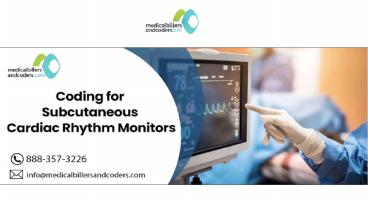Coding for Subcutaneous Cardiac Rhythm Monitors PowerPoint PPT Presentation
Title: Coding for Subcutaneous Cardiac Rhythm Monitors
1
(No Transcript)
2
Coding for Subcutaneous Cardiac Rhythm Monitors
On Nov. 2, 2020, the American Medical Association
(AMA) CPT Editorial Panel announced the approval
of a new Category III CPT code to describe
remote programming of subcutaneous cardiac rhythm
monitors. The new code will be effective July 1,
2021. Please note that the existence of a
Category III CPT code does not guarantee
payment. Category III codes are temporary codes
for emerging technology, services, procedures,
and service paradigm, according to AMAs CPT
Professional 2021 codebook. Payers generally do
not cover such services, so these codes are
primarily for reporting purposes only. 0650T
Code Description 0650T Programming device
evaluation (remote) of subcutaneous cardiac
rhythm monitor system with iterative adjustment
of the implantable device to test the function of
the device and select optimal permanent
programmed values with analysis, review, and
report by a physician or other qualified health
care professional.
3
Coding for Subcutaneous Cardiac Rhythm Monitors
Subcutaneous Cardiac Rhythm Monitors Subcutaneous
cardiac rhythm monitors, also known as
implantable loop recorders or insertable cardiac
monitors, are indicated for adults at risk of
developing an abnormal heart rhythm or have
symptoms that may suggest a cardiac arrhythmia
such as dizziness, palpitations, syncope, chest
pain, and/or shortness of breath. Subcutaneous
cardiac rhythm monitors address an otherwise
unmet clinical need through uninterrupted,
long-term cardiac monitoring for patients with
symptoms which recur too infrequently to be
detected by shorter-term external monitoring
modalities. Within the context of the current
COVID-19 pandemic where remote monitoring has
become essential for device/patient surveillance,
the newly added capability for remote programming
improves patient care while mitigating the
unnecessary exposure risk with in-person
clinic/emergency department/hospital visits.
Coverage for remote programming of these devices
would facilitate clinical decision-making between
physicians and their patients while also avoiding
the costs with in-person clinic office visits.
4
Coding for Subcutaneous Cardiac Rhythm Monitors
- Coding Guidelines
- The programming evaluation of a subcutaneous
cardiac rhythm monitor system may be performed in
person or remotely. Codes 93285, 0650T are
reported per procedure. - Remote programming device evaluation (0650T)
includes in-person device programming (93285),
when performed, on the same day. - Programming device evaluation includes all
components of the interrogation device
evaluation. Therefore, 93291 (in-person
interrogation) should not be reported in
conjunction with 93285, 0650T. - Programming device evaluations (93285, 0650T) and
remote interrogation device evaluations (93298)
may both be reported during the 30- day remote
interrogation device evaluation period. - Do not report 0650T in conjunction with
codes 33285, 93260, 93279, 93280, 93281, 93282,
93284, 93285, 93291. - These types of monitors have been covered by
Medicare since 2004 under the Centers for
Medicare and Medicaid Services (CMS) National
Coverage Determination for Electrocardiographic
Services (20.15), and remote interrogation device
evaluation of these devices has been covered by
Medicare since the creation of Category I CPT
codes in 2009.
5
Coding for Subcutaneous Cardiac Rhythm Monitors
- Functioning of Device
- Patient-activated and automatically recorded
rhythm episodes are reviewed for evidence of
accurately identified arrhythmias. Current data
measurements are compared to stored and trended
historical data. - Device function is assessed for underlying signal
strength and battery longevity. Sensing
thresholds for detecting arrhythmias are
evaluated and adjusted until optimized. The
appropriate rhythm alerts are identified, and
recording parameters are reviewed and adjusted. - Total device memory capacity and parameters for
recording capacity are reviewed. The amount of
episode detection recording time is assessed and
adjusted as needed to optimize the recording
function. - After a detailed evaluation of all parameters, a
decision is made about the adequacy of the
currently programmed parameters, and any
identified device programming changes to optimize
device performance are made and saved in the
remote monitoring system.

